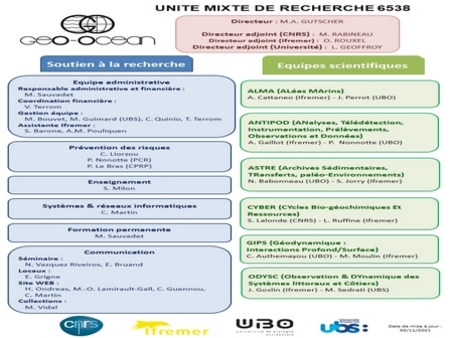Biodiversity
The abyssal domain expands from the continental slope to the deepest ocean depths covering two thirds of the surface of the globe and representing 62 % of the total volume of the biosphere. It is, unquestionably, the largest ecosystem on the planet, but also the least well-known. This environment is dominated by a very varied, minute fauna, made up of original organisms whose biomass remains limited.
Recent results show in the absence of light, and therefore in situ photosynthetic production, abyssal benthic biomass is limited to a few grams of organic matter per square metre and depends directly on surface organic contribution (mainly photosynthetic) in the form of animal waste, remains and particles. More than 1.7 million eukaryotic species have been identified in the biosphere, which could potentially harbour 9 million species including 2.2 million marine species.
Oceanic ridges are known for harbouring hydrothermal sources, home to primary chemosynthetic production providing food for animal communities. The biological interest of the hydrothermal environment, which contrasts with abyssal deserts, is immense. More than 500 hydrothermal species have been identified. This biodiversity has proven to be less significant than the deep benthic compartment, suggesting that exploration and sampling efforts must be maintained. Their original operating mode, their high productive level and their biotope which generates quantities of compounds reputed toxic for life, make them extreme environments compared to others currently more well known. These ecosystems are not yet impacted by human activity making them a genuine witness to evolution by the very nature of the original life they harbour. The micro-organisms colonizing these habitats present remarkable characteristics of significant biotechnological interest (growth in extremely high temperature and high pressure conditions, thermo-stable, original compounds...). Furthermore, we believe there is also underground microbiological activity whose extent and role in geochemical cycles remains to be identified.
Out of the hydrothermal context, the fauna of oceanic ridges remains little studied. Fauna is rare but diverse, small-sized fauna (meiofauna) can also be found in the sediment. There are deep-water coral, sponges, crinoids, small crustaceans such as amphipods and a great diversity of nematodes in the sediment. It would appear that hydrothermal activity has an impact on this fauna and symbioses exist with micro-organisms which provide trophic input.
The active sources of the mid-Atlantic ridge harbour a rich hydrothermal faunal biodiversity.
- The megafauna of central black smokers of TAG is largely dominated by dense clusters of the eyeless shrimp Rimicaris exoculata (up to 1500/m²).
- Anemones (Maractis rimicarivora) and polychaete dominate the periphery.
- Three other species of eyeless shrimp Mirocaris fortunata, Rimicaris chacei and Alvinocaris markensis are also present together with crab (Segonzacia mesatlantica) and other crustaceans (Munidopsis exuta), gastropods (Phymorhynchus moskalevi) and fish (Synaphobranchus kaupi).
- Polychaetes are also present in peripheral sediment.
The fauna of the hydrothermal field of Snake Pit is characterized by a very high concentration of shrimp around the most active vents and plumes, the density can reach up to 2500 individuals/m² for Rimicaris exoculata.
Nearly 50 species live on and around this site:
- The majority of species live on the hive complex (100 m²) except for the bivalve Bathymodiolus identified on the site of Elan (80 m²).
- Gastropods form dense patches (hundreds of individuals per several dm²) around diffuse emissions.
- The shrimp Chorocaris chacei and Alvinocaris spp. are found all over the site of Elan, but are more significantly concentrated around the clusters of Rimicaris exoculata. Microcaris fortunata is more abundant in zones of high biomass (e.g. mussels).
Hydrothermal sites including TAG and Snake Pit harbour symbiotic species associating fauna and chemoautotrophic bacteria (photo on the left) which are their food source. The most studied species are the shrimp Rimicaris exoculata and the mussel Bathymodiolus puteoserpentis. The study of the symbiosis of Rimicaris is now better identified as much in their composition as in their functioning thanks to technological advances (in vivo experiments in pressurized aquariums and metagenomics). Further sampling is required to advance on experiments notably on their life cycle (reproduction, distribution, acquisition of symbionts, symbiosis in juveniles). The symbiosis within the gills of the shrimp Rimicaris chacei also remains to be studied. Bathymodiolus puteoserpentis presents a double sulfo-oxide (using hydrogen sulfide) and methanotrophic (using methane) symbiosis.







